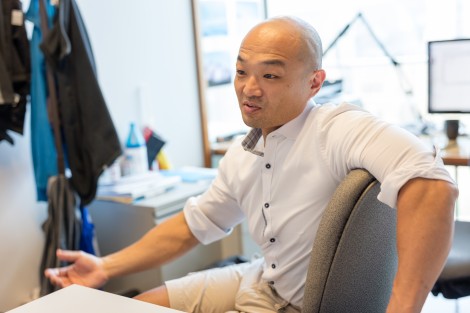[dropcap]I[/dropcap]n the world of drug manufacturing, research and development can take years. U of T Associate Professor Philip Kim has discovered a way to make the process more efficient, which was recently published in Science Advances. Kim and his lab at the Donnelly Centre for Cellular and Biomolecular Research have been able to productively manufacture a class of drugs known as ‘biologics’. Their new method involves combining current protein synthesis methods with computer-aided design.
Biologics differ from regular pharmaceuticals because they can be composed of organic molecules like sugars and proteins; traditional drugs are chemically-manufactured within a lab. Biologics are used to treat or diagnose medical conditions and diseases, but can also be used in vaccines, allergen testing, and blood transfusions. While their organic composition makes them more susceptible to heat and contamination, they can be a more effective method of treatment. In 2015, 40 per cent of drugs in use were biologics and that number is expected to grow.
For Kim, the focus of the study was to improve a human protein’s ability to bind to cells. Proteins are large tangled chains of smaller molecules called ‘amino acids’. The various characteristics of these amino acids enable them to interact with each other, causing the protein to fold, and allowing it to dynamically interact with other molecules around it.
In order to understand and improve upon the binding ability of a protein, the structure and composition of it must first be understood. However, current methods are inefficient. They require testing of all possible amino acid combinations and will not always produce stable or functional end products. Not knowing which protein variations will produce the best result, all combinations are tested, which leads to endless possibilities.
By incorporating computational protein design, scientists are able to knowingly design stable, functional proteins that can tightly bind to their target.
For Kim and his lab, this new method drastically scales down the number of possibilities, reducing the original count from 260 sextillion possible random protein variations to about 6,000.
Computational protein design is not a stand-alone option and would still need to be used alongside typical screening methods, in order to rank the resulting proteins and determine the best candidates for further development.
“It’s analogous to if you build an airplane,” Kim explains. “You still have to go through many cycles of testing. The computer is pretty good at modelling the air flow and that kind of stuff, but it’s not good enough to actually design on a computer and then having it fly the next day. So it’s a lot like that.”
Kim credits the accomplishment to a unique combination of talent, interdisciplinary researchers, and resources within his lab. “Ultimately, I think the reason that we could do that before anybody else is that my lab is a little unique.” He says. “We have people who are very good with computing… and if you combine that with a lot of post docs who are very good at doing experiments… There’s relatively few labs we have that are in the same place. That’s one of the reasons why we could do that when nobody else could.”
Currently, biologics are used in a range of treatments and therapies, from Herceptin in combatting aggressive breast cancer to Abatacept for treatment of rheumatoid arthritis. In some instances, biologics can provide alternatives for patients where there is no other option.
One example is Atryn, a biologic developed in the US that is produced in goats. The human gene anti-thrombin — an anticoagulant which inhibits blood clotting — is inserted into the animals and the protein is extracted from their milk. Atryn is considered a replacement for other conventional methods of anticoagulation, such as blood thinners or human donations, which pose risks of blood loss and disease transmission, respectively.
Kim hopes to make the process of biologics development faster, cheaper, and more efficient. As technology advances, he hopes they will be able to continue to experiment on larger proteins and formulate larger variant libraries to broaden their impact on disease treatment and therapy.
“I’m just a scientist and I’m trying to make the world a better place,” said Kim.




